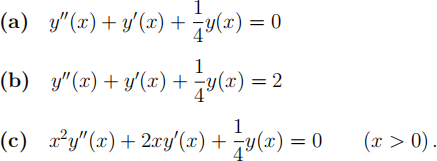Hello, if you have any need, please feel free to consult us, this is my wechat: wx91due
2022–2023, 2nd Semester
Introduction to the Theory of Ordinary Differential Equations
Final Exam ( Sample )
Financial Mathematics 2142
1. Short questions
Complete the sequences!
1.1. Question. The Cauchy problem

is equivalent with the following integral equation:
1.2. Question. Let I denote an open interval such that 0 ∈ I . If the scalar function x : I → R solves the Cauchy problem

then the vector function

solves the following Cauchy problem (involving a system of first order differential equations):
1.3. Question. Let (X, d) denote a metric space.
(a) We call (X, d) complete if
(b) Find an appropriate value of the real number q that makes inequality (5) identically true and admits a valid argument when you fill the blank places with some of the words in brackets [complete, continuous, contraction, root, fixed point, linear]:
Proposition. Let φ : [0, 1] → [0, 1] be given by

Then there exists x0 ∈ [0, 1] fulfilling φ(x0) = x0 .
Proof. One can easily verify the inequality

(with q = ) for every x, y ∈ [0, 1]. Hence φ : [0, 1] → [0,1] is a . . . . . . . . . . . . .
Since [0, 1] is a . . . . . . . . . . . . metric space, we obtain that φ has a . . . . . . . . . . . . .
2. Comprehensive question
2.1. Question. Suppose that n ∈ N , I ⊂ R is an open interval and ai, b: I → R are continuous functions (i = 1, . . . , n). Given τ ∈ I and ξi ∈ R (i = 1, . . . , n), let us consider the equations

Elaborate the theory of the n-th order linear differential equations (without proofs) involving the answers to the following questions:
(a) What can we claim concerning the existence, the uniqueness and the do-main of the maximal solution of the Cauchy problem (6)–(7) ?
(b) Explain the relation between the sets of solutions of the differential equa-tions (6) and (8).
(c) What can we say about the algebraic structure of the set of solutions of the differential equation (8) ?
(d) What is a fundamental set of solutions of (8) ? Define its Wronskian as well!
(e) If a fundamental set of solutions of (8) is given, how can we apply the va-riation of constants in order to determine a solution of the differential equation (6) ?
3. Combined question
3.1. Question. Let D ⊂ R 2 be a connected open domain and P, Q : D → R be continuous functions. Let us consider a differential equation of the form

(a) When do we say that (9) is an exact differential equation? (Write down the proper definition!)
(b) What is the necessary condition fulfilled by exact differential equations with smooth terms?
(c) Describe a related sufficient condition as well!
(d) Verify if the following differential equation is exact and determine its solutions:

4. Practical problems
Details of calculations are required.
4.1. Problem. Solve the Cauchy problem

(involving a separable differential equation).
4.2. Problem. Solve the (Bernoulli type) differential equation

4.3. Problem. Determine the solutions of the following differential equations:

Describe the connections between the solutions of the equations (a) and (b) as well as the connections between the solutions of the equations (a) and (c) !